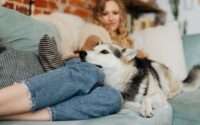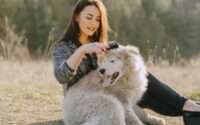How to Keep House Clean When Dog Is in Heat: Your Spotless Home Guide
Welcome to our comprehensive guide on maintaining a clean and comfortable home when your beloved canine companion is in heat. At BarkLikeMeow, we understand that your dog’s well-being and your home’s cleanliness are of utmost importance. That’s why we’ve put together this detailed guide to help you navigate this challenging time with ease.
Understanding Your Dog’s Heat Cycle
A dog’s heat cycle, also known as estrus, is a natural biological process. Understanding the stages of this cycle can go a long way in managing the cleanliness of your home:
Explanation of the Different Stages of a Dog’s Heat Cycle
- Proestrus: This initial stage is marked by behavioral changes, but your dog isn’t fertile yet. It typically lasts for about 9-11 days.
- Estrus: This is when your dog becomes fertile and will actively seek a mate. It typically lasts around 9-11 days but can vary.
- Diestrus: If your dog does not mate, she enters diestrus, which is a period of sexual inactivity that lasts for several weeks.
- Anestrus: This is the resting phase of the heat cycle, and it can last for several months.
Behavioral Changes During Each Stage
During proestrus and estrus, your dog may exhibit various behavioral changes such as increased affection, restlessness, and frequent urination. These changes can impact your home’s cleanliness.
Signs That Indicate Your Dog Is in Heat
It’s essential to be able to recognize the signs of your dog being in heat, which include swelling of the vulva, a bloody discharge, and increased attention from male dogs.
In the sections that follow, we’ll provide you with practical tips and strategies to maintain a clean and hygienic environment for your dog and your home during this challenging time. We understand that it can be a bit overwhelming, but with the right knowledge and preparation, you can navigate your dog’s heat cycle with confidence and ease.
Preparing Your Home
Ensuring your home is well-prepared for your dog’s heat cycle is a crucial step in maintaining cleanliness and comfort. Here are some tips to help you create the perfect environment:
Creating a Designated Area for Your Dog
- Using a Comfortable Crate or Pen: Provide your dog with a cozy and secure space, like a comfortable crate or playpen. This not only helps with cleanliness but also gives your dog a sense of security during this time.
- Puppy Pads and Bedding: Line your dog’s designated area with puppy pads to catch any potential messes. Adding soft, washable bedding will keep your dog comfortable and make cleanup easier.
Dog-Proofing Your Home
- Removing Hazards: Take time to dog-proof your home by removing any potential dangers or items your dog might chew on or knock over during her heat cycle.
- Childproofing Techniques: Employ childproofing techniques like gating off areas of your home to limit your dog’s access, especially if you have other pets or young children.
Stocking Up on Cleaning Supplies
- Pet-Safe Cleaning Products: Invest in pet-safe cleaning products that are effective in neutralizing odors and removing stains without posing any harm to your dog.
- Cleaning Tools and Equipment: Gather the necessary cleaning tools and equipment, including paper towels, enzymatic cleaners, and a reliable vacuum cleaner, to streamline your cleanup efforts.
Maintaining Hygiene During Your Dog’s Heat Cycle
Maintaining your dog’s hygiene is not only essential for her well-being but also for a clean living space. Here’s how you can keep your dog comfortable and minimize the impact of her heat cycle on your home:
Grooming Your Dog
- Bathing and Brushing: Regular bathing and brushing will help keep your dog clean and reduce the risk of odors. Use a dog-friendly shampoo and conditioner, and pay extra attention to her genital area.
- Preventing Odors: Consider using specialized pet deodorizing products to keep your dog smelling fresh. Additionally, regular brushing will help remove loose fur and prevent matting.
Monitoring Your Dog’s Discharge
- Appropriate Doggy Diapers: Invest in high-quality doggy diapers that are designed for females in heat. These diapers are designed to stay in place and provide a comfortable fit for your dog.
- Regular Changes and Cleaning: Change your dog’s diaper regularly to prevent irritation and discomfort. Cleanse the genital area with pet-safe wipes as needed to maintain hygiene.
Keeping Your Dog Comfortable
- Providing Fresh Water: Ensure your dog has access to clean, fresh water at all times. Increased urination during her heat cycle can lead to dehydration, so make sure she stays well-hydrated.
- Adjusting Temperature: Dogs in heat may feel warmer than usual, so adjust the room temperature to keep your dog comfortable. Avoid exposing her to extreme heat or cold.
By implementing these preparations and hygiene practices, you can create a clean and comfortable environment for both you and your dog during her heat cycle. In the next sections, we’ll delve into effective cleaning strategies and outdoor care to further enhance the cleanliness of your home.
Cleaning Strategies
Maintaining a clean and fresh-smelling home during your dog’s heat cycle is achievable with the right cleaning strategies in place. Here’s how you can keep your living space spotless:
Daily Cleaning Routine
- Sweeping and Vacuuming: Regularly sweep or vacuum your floors to pick up stray hairs, dirt, and debris. Investing in a vacuum cleaner designed for pet hair can make this task more efficient.
- Wiping Down Surfaces: Keep surfaces like countertops and furniture clean by wiping them down daily with pet-safe disinfectant wipes. This prevents the buildup of odors and potential stains.
Managing Odors
- Odor-Neutralizing Products: Utilize pet-friendly odor-neutralizing products to eliminate any unwanted smells. Products with enzymes specifically target and break down pet odors.
- Natural Remedies: Consider using natural remedies like baking soda to absorb odors. Sprinkle a thin layer on carpets and upholstery, let it sit for a while, then vacuum it up.
Dealing with Accidents
- Immediate Cleanup: Accidents happen, so it’s crucial to clean them up promptly. Blot any urine or other fluids with paper towels, and then treat the affected area with an enzymatic cleaner to break down stains and odors.
- Stain and Odor Removal Tips: For tough stains, consult pet stain removal guides or contact professional cleaners who specialize in pet-related accidents.
Outdoor Care
While indoor cleanliness is vital, outdoor care plays a significant role in managing your dog’s heat cycle. Here’s how you can ensure a clean and safe outdoor environment:
Walks and Exercise
- Choosing Appropriate Locations: When taking your dog for walks or exercise, select areas that are less frequented by other dogs to minimize potential encounters. This reduces the risk of unplanned mating attempts.
- Cleaning Up After Your Dog: Always carry poop bags and promptly clean up after your dog. Proper disposal of waste helps keep public spaces clean and maintains good community relations.
Yard Maintenance
- Fencing and Containment: Ensure your yard is securely fenced to prevent your dog from escaping and encountering male dogs. Regularly inspect and maintain the fence to address any potential escape routes.
- Regular Cleanup: Periodically clean your yard of waste and debris to maintain a clean outdoor environment. This also reduces the attraction of other animals to your property.
By following these cleaning strategies and outdoor care tips, you can create a clean and safe environment for your dog during her heat cycle. Remember, a clean home and outdoor space contribute to your dog’s overall comfort and well-being.
Health and Safety Considerations
Ensuring your dog’s health and safety is paramount during her heat cycle. Here’s what you need to know to keep your furry friend in the best condition:
Vet Visits and Consultations
- Checking Your Dog’s Overall Health: Schedule a visit to your veterinarian before or early in your dog’s heat cycle. Your vet will assess her overall health and provide guidance on managing the cycle.
- Discussing Spaying Options: If you’re not planning to breed your dog, discuss spaying with your vet. Spaying can prevent future heat cycles and the associated challenges.
Avoiding Unwanted Pregnancies
- Responsible Ownership: If you’re not prepared for a litter of puppies, it’s crucial to take responsible steps to avoid unwanted pregnancies. Keep your dog indoors or under strict supervision when outside.
- Discussing Birth Control Methods: Consult with your vet about birth control options for your dog. They can provide information on safe and effective methods to prevent pregnancy.
Behavioral Tips
Your dog’s behavior during her heat cycle can vary, and it’s essential to address any changes and challenges:
Training During the Heat Cycle
- Managing Increased Aggression: Some dogs may become more territorial or aggressive during their heat cycle. Use positive reinforcement training techniques to manage these behaviors, and consider consulting a professional trainer if needed.
- Reinforcing Good Behavior: Reward and reinforce good behavior with treats and praise. Consistency in training will help your dog understand what is expected of her.
Reducing Stress and Anxiety
- Comfort Items and Safe Spaces: Create a safe and comfortable space for your dog where she can retreat when she needs privacy or relaxation. Provide her with familiar toys and blankets.
- Bonding Time: Spend quality time with your dog to provide reassurance and reduce stress. Gentle petting, playtime, and soothing words can go a long way in helping her feel secure.
By addressing these health, safety, and behavioral considerations, you’ll not only maintain a clean home but also ensure your dog’s well-being during her heat cycle. Remember that every dog is unique, so it’s essential to tailor your approach to your dog’s specific needs.
Coping with the End of the Heat Cycle
As your dog’s heat cycle comes to a close, it’s important to manage the transition smoothly. Here’s what you can expect and how to ensure a seamless return to your normal routine:
Signs That Your Dog’s Heat Cycle Is Ending
- Reduction in Discharge: You’ll notice a decrease in the bloody discharge as your dog’s heat cycle concludes.
- Behavioral Changes: Your dog’s behavior will likely return to her usual self, with reduced restlessness and seeking out male dogs.
Transitioning Back to a Normal Cleaning Routine
- Gradual Cleanup: As your dog’s discharge diminishes, you can gradually reduce the frequency of cleaning. Continue to monitor for any residual odors or stains.
- Deep Cleaning: Consider a thorough deep cleaning of your home to ensure all traces of your dog’s heat cycle are eliminated.
Post-Cycle Grooming and Care
- Grooming: Resume your regular grooming routine, which may include bathing, brushing, and nail trimming.
- Consult with Your Vet: Schedule a follow-up visit with your veterinarian to ensure your dog is in good health and discuss any concerns.
Conclusion
We hope this comprehensive guide has equipped you with the knowledge and tools to keep your house clean and your dog comfortable during her heat cycle. Remember, patience, care, and responsible ownership are essential not only for maintaining a clean environment but also for your dog’s well-being.
As dog lovers ourselves, we understand the challenges and rewards of caring for our four-legged family members. By following the tips and strategies outlined in this guide, you can navigate your dog’s heat cycle with confidence and ease, ensuring a clean and loving home for both you and your furry friend.
At BarkLikeMeow, we’re committed to providing pet owners like you with valuable resources and support to make pet parenting a joyful experience. If you have any questions or need further assistance, don’t hesitate to reach out to our community of dog lovers and experts. Together, we can create a happier and healthier life for our beloved pets.
Frequently Asked Questions
What is a dog’s heat cycle?
A dog’s heat cycle, or estrus, is a reproductive phase that includes four stages. The most significant concerns for cleanliness are proestrus and estrus when your dog may have vaginal discharge and increased interest from male dogs.
How can I create a designated area for my dog during her heat cycle?
Use a comfortable crate or playpen lined with puppy pads and bedding. Ensure this space is secure, cozy, and easily accessible for your dog.
What pet-safe cleaning products should I use?
Opt for pet-safe enzymatic cleaners, disinfectants, and odor-neutralizers to effectively clean any messes without harming your dog.
Is spaying the only way to prevent unwanted pregnancies during the heat cycle?
No, there are other birth control methods available. Consult with your veterinarian to explore safe and effective options for your dog.
How often should I change my dog’s diaper during her heat cycle?
Change the diaper regularly, usually every 2-4 hours, to prevent irritation and maintain cleanliness.
What can I do to reduce stress and anxiety in my dog during her heat cycle?
Provide comfort items, a safe space, and quality bonding time. Gentle petting and playtime can help reduce stress and anxiety.
Can I let my dog outside during her heat cycle?
Yes, but always supervise her and ensure your yard is securely fenced to prevent interactions with male dogs. Maintain outdoor cleanliness by promptly picking up her waste.
When does a dog’s heat cycle end, and how should I transition back to a normal routine?
The heat cycle typically lasts 2-4 weeks. As it ends, gradually reduce your cleaning frequency and perform a deep cleaning to ensure a spotless home. Resume your dog’s regular grooming routine, and consult your vet for a post-cycle checkup.
Are there any natural remedies to control odors during my dog’s heat cycle?
Yes, you can use natural remedies like baking soda to absorb odors. Sprinkle a thin layer on carpets and upholstery, let it sit for a while, then vacuum it up.
Is it possible for a spayed dog to still have heat-like symptoms?
Yes, in rare cases, some dogs may exhibit signs similar to a heat cycle even after being spayed. Consult your vet if you notice unusual symptoms.




